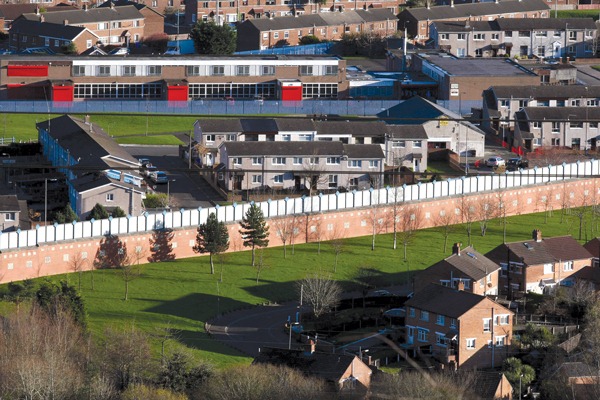On the move in Belfast
3rd July 2012Poverty levels in Northern Ireland
3rd July 2012Calls to tackle segregation
MLAs have voted against a review of segregation and a duty to share, leading to doubts over the new housing strategy’s ambitions.
Housing organisations and political parties are waiting to see what Nelson McCausland’s goal of “communities of good neighbours” will mean in practice when his housing strategy is announced.
Residential segregation still shapes Northern Ireland’s housing landscape 14 years after the Good Friday Agreement. An area is officially considered ‘single-identity’ if 90 per cent or more residents come from one community.
The Housing Executive estimates that 90 per cent of its estates are single-identity. Taking a wider view, the 2001 census indicated that that 44 per cent of Catholics and 30 per cent of Protestants lived in single-identity areas.
Queen’s University Belfast geographers Ian Shuttleworth and Chris Lloyd carried out a detailed analysis of segregation in Belfast in 2007, followed by another study of estates outside the city in 2009. Both studies used 2001 census data and an 80 per cent threshold for single-identity status.
For context, the Catholic population of Belfast has remained relatively constant: 107,815 in 1971 and 109,141 in 2001. The Protestant population, though, sharply declined from 211,140 to 102,621, partly due to suburbanisation. This was, in turn, reflected in social housing composition.
Polarisation rose rapidly over the Troubles and during the early peace process. Ninety-one per cent of Belfast estates, home to 65,492 residents, were polarised by 2001.
When the analysis was repeated outside Belfast, the authors concluded that another 246,290 residents were living in polarised estates. Segregation was highest in Derry and mid-Ulster i.e. Cookstown, Dungannon and Craigavon, reflecting those areas’ experience of the Troubles.
As the Community Relations Council’s first peace monitoring report (February 2012) explained, residents choose to live in areas which they consider safe. Segregation is therefore a “self-selection process” rather than an imposed policy. That said, the 2010 Northern Ireland Life and Times Survey indicated that 83 per cent of people would prefer to live in a mixed religion neighbourhood.
A study by fellow Queen’s academic Brendan Murtagh in 2008 indicated that while middle class areas were becoming more mixed (with an influx of Catholic graduates in Belfast), segregation in working class areas remained unchanged. Small area data for the 2011 Census will be released in spring 2013.
The Girdwood Barracks dispute brought housing segregation back into the headlines, and reached the floor of the Assembly on 12 June. The Alliance Party brought forward a motion calling for a “landmark review of segregation” with the aim of eliminating both segregation and discrimination, and a duty on the Housing Executive “to promote and protect all housing as mixed.”
Alliance MLA Judith Cochrane welcomed existing work e.g. the Shared Neighbourhood Programme. An anti-segregation approach would still allocate social housing on objective need but robustly tackle intimidation caused by flags, emblems, murals and paramilitary symbols.
She was disappointed that the Housing Executive’s website said that it supported the wishes of people who chose to live in single-identity neighbourhoods: “Are we to take it that if people asked for a white-only estate, the Housing Executive would support the wishes of people to live there?”
The SDLP said that segregation should be dealt with in the forthcoming housing strategy. For Sinn Féin, Gerry Kelly claimed that “forced shared housing” did not work. UUP MLA Michael Copeland was wary of quotas that went beyond need.
Nelson McCausland was reluctant to discuss the housing strategy before it was announced. He rejected a review, as the problem was already well-known, and claimed that a duty “simply will not work.” More mixed tenure housing, he suggested, would help to reduce segregation.
DUP and Sinn Féin speakers emphasised that residents had to choose whether to share. However, Alliance’s Chris Lyttle claimed that this was already made clear in the Life and Times Survey. The motion was rejected by 62 votes to 18.







